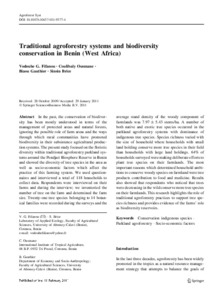| dc.contributor.author | Fifanou, V.G. |
| dc.contributor.author | Ousmane, C. |
| dc.contributor.author | Gauthier, B. |
| dc.contributor.author | Brice, S. |
| dc.date.accessioned | 2019-12-04T11:10:31Z |
| dc.date.available | 2019-12-04T11:10:31Z |
| dc.date.issued | 2011-05 |
| dc.identifier.citation | Fifanou, V.G., Ousmane, C., Gauthier, B. & Brice, S. (2011). Traditional agroforestry systems and biodiversity conservation in Benin (West Africa). Agroforestry Systems, 82(1), 1-13. |
| dc.identifier.issn | 0167-4366 |
| dc.identifier.uri | https://hdl.handle.net/20.500.12478/2174 |
| dc.description.abstract | In the past, the conservation of biodiversity has been mostly understood in terms of the management of protected areas and natural forests, ignoring the possible role of farm areas and the ways through which rural communities have promoted biodiversity in their subsistence agricultural production systems. The present study focused on the floristic diversity within traditional agroforestry parkland systems around the Pendjari Biosphere Reserve in Benin and showed the diversity of tree species in the area as well as socio-economic factors which affect the practice of this farming system. We used questionnaires and interviewed a total of 118 households to collect data. Respondents were interviewed on their farms and during the interview; we inventoried the number of tree on the farm and determined the farm size. Twenty-one tree species belonging to 14 botanical families were recorded during the surveys and the average stand density of the woody component of farmlands was 7.97 ± 5.43 stems/ha. A number of both native and exotic tree species occurred in the parkland agroforestry systems with dominance of indigenous tree species. Species richness varied with the size of household where households with small land holding conserve more tree species in their field than households with large land holdings. 64% of households surveyed were making deliberate efforts to plant tree species on their farmlands. The most important reasons which determined household ambitions to conserve woody species on farmland were tree products contribution to food and medicine. Results also showed that respondents who noticed that trees were decreasing in the wild conserve more tree species on their farmlands. This research highlights the role of traditional agroforestry practices to support tree species richness and provides evidence of the farms’ role as biodiversity reservoirs. |
| dc.description.sponsorship | United Nations Educational, Scientific and Cultural Organization |
| dc.language.iso | en |
| dc.subject | Conservation |
| dc.subject | Indigenous Species |
| dc.subject | Agroforestry |
| dc.subject | Biodiversity Conservation |
| dc.title | Traditional agroforestry systems and biodiversity conservation in Benin (West Africa) |
| dc.type | Journal Article |
| dc.description.version | Peer Review |
| cg.contributor.affiliation | Université d'Abomey Calavi |
| cg.contributor.affiliation | International Institute of Tropical Agriculture |
| cg.coverage.region | Africa |
| cg.coverage.region | West Africa |
| cg.coverage.country | Benin |
| cg.isijournal | ISI Journal |
| cg.authorship.types | CGIAR and developing country institute |
| cg.iitasubject | Biodiversity |
| cg.journal | Agroforestry Systems |
| cg.howpublished | Formally Published |
| cg.accessibilitystatus | Limited Access |
| local.dspaceid | 90905 |
| cg.identifier.doi | https://dx.doi.org/10.1007/s10457-011-9377-4 |

